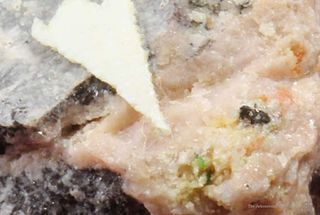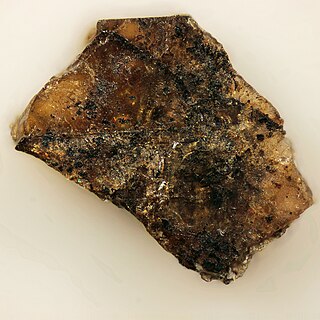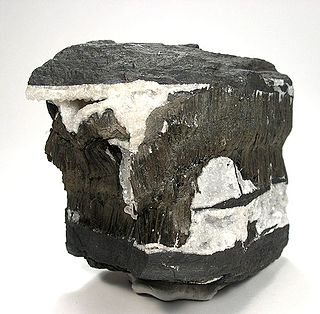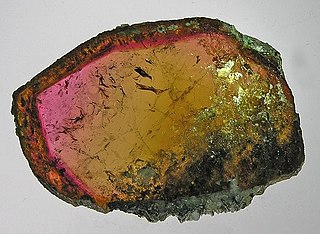 W
WAkrochordite is an exceptionally rare hydrated hydrous arsenate mineral of the formula (Mn,Mg)4(AsO4)2(OH)4.4H2O and represents a small group of rare in the nature manganese (Mn) arsenates and, similarly to most other Mn-bearing arsenates, possess pinkish colour. It is typically associated with metamorphic Mn deposits.
 W
WAndrianovite is a very rare mineral of the eudialyte group, with formula Na12(K,Sr,Ce)6Ca6(Mn,Fe)3Zr3NbSi(Si3O9)2(Si9O27)2O(O,H2O,OH)5. The original formula was extended to show the presence of cyclic silicate groups and silicon at the M4 site, according to the nomenclature of eudialyte group. Andrianovite is unique among the eudialyte group in being potassium-rich (other eudialyte-group species with essential K are davinciite and rastsvetaevite). It is regarded as potassium analogue of kentbrooksite, but it also differs from it in being oxygen-dominant rather than fluorine-dominant. Also, the coordination number of Na in this representative is enlarged from 7 to 9. The name of the mineral honors Russian mathematician and crystallographer Valerii Ivanovich Andrianov.
 W
WAzoproite is a rare manganese iron borate mineral with the chemical formula (Mg,Fe2+)2(Fe3+,Ti,Mg)(BO3)O2. It was first identified near Lake Baikal, Russia. It was named after the Association pour l'Etude Géologique des Zones Profondes de l'Ecorce Terrestre, whose acronym is AZOPRO in Russian.
 W
WBabingtonite is a calcium iron manganese inosilicate mineral with the formula Ca2(Fe,Mn)FeSi5O14(OH). It is unusual in that iron(III) completely replaces the aluminium so typical of silicate minerals. It is a very dark green to black translucent (in thin crystals or splinters) mineral crystallizing in the triclinic system with typically radial short prismatic clusters and druzy coatings. It occurs with zeolite minerals in cavities in volcanic rocks. Babingtonite contains both iron(II) and iron(III) and shows weak magnetism. It has a Mohs hardness of 5.5 to 6 and a specific gravity of 3.3.
 W
WCoronadite is a black monoclinic mineral containing a ternary oxide of lead and manganese in two oxidation states. The mineral was named after Francisco Vasquez de Coronado who was an explorer of southwest USA. The name was made up by Waldemar Lindgren in 1905.
 W
WEudialyte, whose name derives from the Greek phrase Εὖ διάλυτος eu dialytos, meaning "well decomposable", is a somewhat rare, nine member ring cyclosilicate mineral, which forms in alkaline igneous rocks, such as nepheline syenites. Its name alludes to its ready solubility in acid.
 W
WGeorgbarsanovite is a very rare mineral of the eudialyte group, formerly known under unaccepted name as barsanovite, with formula Na12(Mn,Sr,REE)3Ca6Fe32+Zr3NbSi(Si3O9)2(Si9O27)2O4Cl2·H2O. The original formula was extended to show the presence of cyclic silicate groups and domination of silicon at the M4 site. "REE", standing for rare earth elements, are dominated by cerium. Georgbarsanovite characterizes in dominance of manganese at the N4 site. It also differs from most other accepted group representatives in its colour. The mineral was found in nepheline pegmatite nearby Petrelius river, Khibiny massif, Kola Peninsula, Russia. It is named after Russian mineralogist Georg Barsanov.
 W
WHauerite is a manganese sulfide mineral with the chemical formula MnS2. It forms reddish brown or black octahedral crystals with the pyrite structure and it is usually found associated with the sulfides of other transition metals such as rambergite. It occurs in low temperature, sulfur rich environments associated with solfataras and salt deposits in association with native sulfur, realgar, gypsum and calcite.
 W
WJanggunite is a rare manganese oxide mineral with formula Mn5−x(Mn,Fe)1+xO8(OH)6.
 W
WKentbrooksite is a moderately rare mineral of the eudialyte group, with formula (Na,REE)15(Ca,REE)6Mn3Zr3NbSi[(Si9O27)2(Si3O9)2O2]F2·2H2O. This extended formula shows the presence of cyclic silicate groups and dominance of Si at the M4 site, according to the nomenclature of the eudialyte group. The characteristic features of kentbrooksite, that make it different from eudialyte are: (1) dominancy of fluorine (the only currently known example among the whole group), (2) dominancy of manganese, and (3) dominancy of niobium. Trace hafnium and magnesium are also reported. Kentbrooksite is relatively common when compared to most other species of the group.
 W
WPolymetallic nodules, also called manganese nodules, are rock concretions on the sea bottom formed of concentric layers of iron and manganese hydroxides around a core. As nodules can be found in vast quantities, and contain valuable metals, deposits have been identified as having economic interest.
 W
WManganokhomyakovite is a very rare mineral of the eudialyte group, with formula Na12Sr3Ca6Mn3Zr3WSi(Si9O27)2(Si3O9)2O(O,OH,H2O)3(OH,Cl)2. This formula is in extended form (based on the original one), to show the presence of cyclic silicate groups and domination of silicon at the M4 site, basing on the nomenclature of the eudialyte group. Some niobium substitutes for tungsten in khomyakovite. As suggested by its name, manganokhomyakovite is a manganese-analogue of khomyakovite, the latter being more rare. The two minerals are the only group representatives, beside taseqite, with species-defining strontium, although many other members display strontium diadochy. Manganokhomyakovite is the third eudialyte-group mineral with essential tungsten (after johnsenite-(Ce) and khomyakovite).
 W
WPhlogopite is a yellow, greenish, or reddish-brown member of the mica family of phyllosilicates. It is also known as magnesium mica.
 W
WPovondraite is a rare silicate mineral from the tourmaline group with formula: NaFe3+3(Fe3+4,Mg2)(BO3)3Si6O18(OH)3O. It is a dark brown to black nearly opaque mineral with a resinous to splendent luster. It crystallizes in the trigonal crystal system as equant, distorted prisms with trigonal pyramid terminations.
 W
WSerrabrancaite, MnP(O4 (H)2 ( O), is a mineral named for the locality where it was found, the Alto Serra Branca Pegmatite. The Alto Serra Branca mine has been in operation since the 1940s. It is located in Paraiba, Brazil near a village named Pedra Lavrada. Tantalite is the main mineral mined here. Specimens of serrabrancaite are kept in the Mineralogical Collections of both the Bergakademie Freiberg, Germany and the Martin-Luther Universität Halle, Institut für Geologische Wissenschaften.
 W
WStrunzite (Mn2+Fe3+2(PO4)2(OH)2{{·}}6H2O) is a light yellow mineral of the strunzite group, first discovered in 1957.
 W
WSugilite ( SOO-gi-lyt) is a relatively rare pink to purple cyclosilicate mineral with the complex chemical formula KNa2(Fe, Mn, Al)2Li3Si12O30. Sugilite crystallizes in the hexagonal system with prismatic crystals. The crystals are rarely found and the form is usually massive. It has a Mohs hardness of 5.5 to 6.5 and a specific gravity of 2.75 to 2.80. It is mostly translucent.
 W
WTodorokite is a rare complex hydrous manganese oxide mineral with the formula (Na,Ca,K,Ba,Sr)1-x(Mn,Mg,Al)6O12·3-4H2O. It was named in 1934 for the type locality, the Todoroki mine, Hokkaido, Japan. It belongs to the prismatic class 2/m of the monoclinic crystal system, but the angle β between the a and c axes is close to 90°, making it seem orthorhombic. It is a brown to black mineral which occurs in massive or tuberose forms. It is quite soft with a Mohs hardness of 1.5, and a specific gravity of 3.49 - 3.82. It is a component of deep ocean basin manganese nodules.
 W
WTourmaline is a crystalline boron silicate mineral compounded with elements such as aluminium, iron, magnesium, sodium, lithium, or potassium. Tourmaline is classified as a semi-precious stone. This gemstone can be found in a wide variety of colors.
 W
WTusionite is a rare colorless to transparent to translucent yellow brown trigonal borate mineral with chemical formula: MnSn(BO3)2. The mineral is composed of 18.86% manganese, 40.76% tin, 7.42% boron, and 32.96% oxygen. It is a late stage hydrothermal mineral and occurs rarely in granite pegmatites in miarolitic cavities.
 W
WUmber is a natural brown or reddish-brown earth pigment that contains iron oxide and manganese oxide. Umber is darker than the other similar earth pigments, ochre and sienna.
 W
WYuksporite is a rare inosilicate mineral with double width, unbranched chains, and the complicated chemical formula K4(Ca,Na)14Sr2Mn(Ti,Nb)4(O,OH)4(Si6O17)2(Si2O7)3(H2O,OH)3. It contains the relatively rare elements strontium, titanium and niobium, as well as the commoner metallic elements potassium, calcium, sodium and manganese. As with all silicates, it contains groups of linked silicon and oxygen atoms, as well as some associated water molecules.
 W
WZirsilite-(Ce) is a very rare mineral of the eudialyte group, with formula (Na,[])12(Ce,Na)3Ca6Mn3Zr3NbSi(Si9O27)2(Si3O9)2O(OH)3(CO3)•H2O. The original formula was extended to show the presence of cyclic silicate groups and the presence of silicon at the M4 site, according to the nomenclature of the eudialyte group.according to the nomenclature of eudialyte group. Zirsilite-(Ce) differs from carbokentbrooksite in cerium-dominance over sodium only. Both minerals are intimately associated. The only other currently known representative of the eudialyte group having rare earth elements (in particular cerium, as suggested by the "-Ce)" Levinson suffix in the name) in dominance is johnsenite-(Ce).
 W
W